With the completion of my second IRONMAN triathlon (i.e. 2.4 mile swim, 112 mile bike, 26.2 mile run) a couple weeks ago, my racing season has officially come to a close. It was a long one and it certainly had many ups and downs, but it ended better than expected and I couldn’t feel prouder of my achievements. In this post, I’m going to reflect on my experiences, what I’ve learned, and how you can use this information in your own journey to improve your health, fitness, and overall quality of life.
Curiosity
In September of 2018, it all started with curiosity. The words “I wonder if…” casually popped into my head just a few weeks after I finished the Chicago Sprint Triathlon, placing 5th out of 137 males in my age group (my best performance at any distance in a field that large). The multisport fire had definitely been reignited within me two years after finishing my first IRONMAN in 2016. As I casually surfed through the IRONMAN website in search of possible races, one local race stood out in particular. Known for its tough bike course and hilly profile, the race in Madison, Wisconsin caught my attention. I knew I was moving to Las Vegas at the end of 2019, so this was my best shot to train for it effectively while I was still local. Could I do it? Could I manage training for an iron-distance triathlon, keeping up with my graduate degree studies, and working part-time at The Foundry, all while commuting from Northwest Indiana five days a week? Well, even though I think I bit off a little more than I could chew, I decided this was it. I was going to take the plunge and commit to it. I registered for the race the day it opened.
The Season Begins
I began training in January after coming back home from some holiday travel. Looking back at it now, I definitely started training too soon, but I couldn’t hold back the excitement and eagerness for another big season of training and racing. The training volume gradually increased and I spent many early morning hours throughout the rest of winter preparing myself for what was to come. Much of that time was spent indoors on the bike trainer and indoor track while the weather was still crappy. I knew the bike portion of the race has always been my weakest, so I really wanted to make sure I was prepared for the challenging course in Madison. I prioritized my weakness and continued to bolster my strengths (i.e. swimming and running). As I continued to train, Madison was still quite far away, so I had to set my sights on races which were closer and would still help me prepare for my ultimate goal. I planned to race an olympic-distance triathlon in May and a 70.3 (i.e. ½ IRONMAN) in June leading up to the big event. Racing these two events would give me the experience I needed to be comfortable in Madison on race day, and they would provide me with opportunities to test myself and see where I was with my training. The first race, Thunder in the Valley, an olympic-distance tri (.9 mile swim, 26 mile bike, 6.2 mile run), was in Terre Haute, IN. It would turn out to be a disaster, but it also may have been one of the largest contributors to my success in Madison.
A Lesson from Failure: the first race
It was finally Spring (or was it). May 2018 had rolled around and it was time to compete in my first triathlon of the season. Sure, Wisconsin was on my mind, but that wasn’t my only goal. After placing really well in the Chicago Sprint Tri in 2017, I wanted to take this opportunity to place at least 3rd in my age group in an olympic-distance race, and I was ready for it. The temperature forecast for race morning was predicted to be in the upper 40s, not quite the temperature I was hoping for. I checked in the day prior and was fortunate to speak with the race director for a while at the race site. I asked some questions about the race and what I could expect. One of the things he told me to do was to take an extra couple minutes in transition (after exiting the swim) to wipe myself dry (especially the feet), because the wind chill on the bike was no joke with those low temperatures. I listened, and planned to do exactly that. Well, my ego and impatience got the best of me.
Race morning came around and I was amped and ready to go. I jumped into the water and swam my best 1500m open water time before getting out and running to the transition area. By the time I reached my bike, my feet were already freezing and partially numb from the cold. A few minutes had already passed since I exited the water and I saw my race time gradually increase. As I was fumbling to remove my wetsuit, I decided to take a risk. Should I spend a couple extra minutes drying my feet and body (as the race director recommended) or should I save the couple minutes, throw some socks onto my wet feet, and see what happens. I went with the second option. This turned out to be the wrong choice. I was riding hard on the bike and the wind chill was miserable. About 5 miles in, both feet went completely numb and I could barely pedal anymore. I began considering the possibility of damage to my feet if I continued the race. I don’t think frostbite or damage to the toes was likely, but I didn’t know and I didn’t want to risk it. As upset as I was about it, I decided to stop and drop out of the race. My lack of preparation for the temperature and my impatience had cost me the opportunity to see the podium for the first time in an olympic-distance triathlon. Yes, I wanted to do well in this race, but my season was not over. I would have to accept the results and learn from them if I was to succeed in my upcoming races.
Bouncing Back: setting myself up for success
Up until the Thunder in the Valley (TIV) tri I had been training for a solid 4 months and I was ready for a break, especially after the outcome of that race. I took a transition period of one week, where I did no structured training and I would only do spontaneous workouts. I needed this transition, because the emotional and physical stress of training was starting to take its toll on my quality of life. Luckily, I had planned this transition week during a family vacation to Key West. I hadn’t seen my girlfriend (now fiance) in 4 months, as we have been in a long-distance relationship for quite some time. It was during this week that I decided to propose to her and make a life-long commitment.
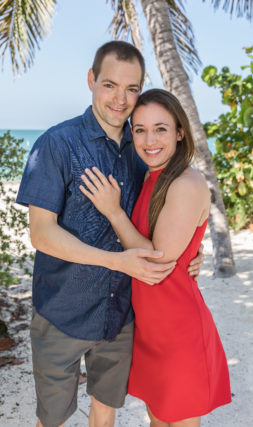

The week seemed to fly by so quickly, and before I knew it I was back home and ready to begin another phase of training. It was time to set my performance at TIV aside and reference the lessons learned from that experience when the time was right. For now, IRONMAN 70.3 Steelhead (1.2 mile swim, 56 mile bike, 13.1 mile run) in Benton Harbor, MI was looming on the horizon. Training shifted from a focus on short-course to long-course strategy. Training for and racing these longer distances requires much more planning in regards to nutrition and pacing strategies. It’s a completely different beast, and having taken some time off, I was up to the task.
The weather was finally starting to feel more like summer, and for the next couple months leading up to the race on June 30th, I really enjoyed my time training outside. I took every chance I had to take my training outdoors. The weekends were spent doing long, multi-hour rides and runs, and I discovered that Ohio Street Beach in Chicago was a great place to do my open water swims. My body was feeling great, but of course about 2 weeks before my race, knee pain surfaced on the bike. I’ve always had chronic knee issues that would come and go since around 2013, when I began hard physical training in the Navy. These are issues I’ve learned to manage with foam rolling techniques, strength training exercises, and proper recovery. Even so, it was quite frustrating to me that I felt great, with no injuries, until just a couple weeks before my next important race. Unfortunately, I had to back off the bike training to make sure I didn’t make matters worse for the race.
It was race day. I had done some physical therapy and taped my knee up for support. Unlike TIV, the weather on this day was immaculate (low 70s, mostly sunny, little wind). My goal for the race was to finish under 5 hours and 30 minutes. I finished the swim in the lake feeling pretty strong as I transitioned to the bike. The knee was feeling good through the first 15 miles or so, then the pain in my quadriceps tendon started to surface again. I had to finish the rest of the 56 mile bike course with this terrible aching pain. Every, single, pedal stroke. It sucked. Finally, I got off the bike, and had no issues on the run. I paced it well, and left enough in the tank for a strong push to the finish in the last couple of miles. I finished the race in 5:28:15, just under my goal time! It was an awesome bounce-back race and I proved to myself that I could learn to adapt my training and racing strategy in the face of untimely adversity.
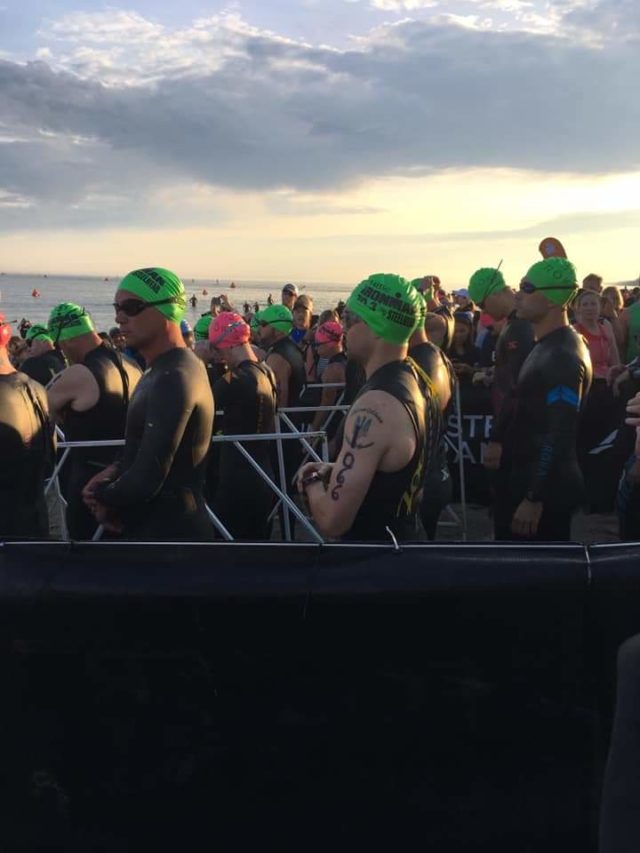
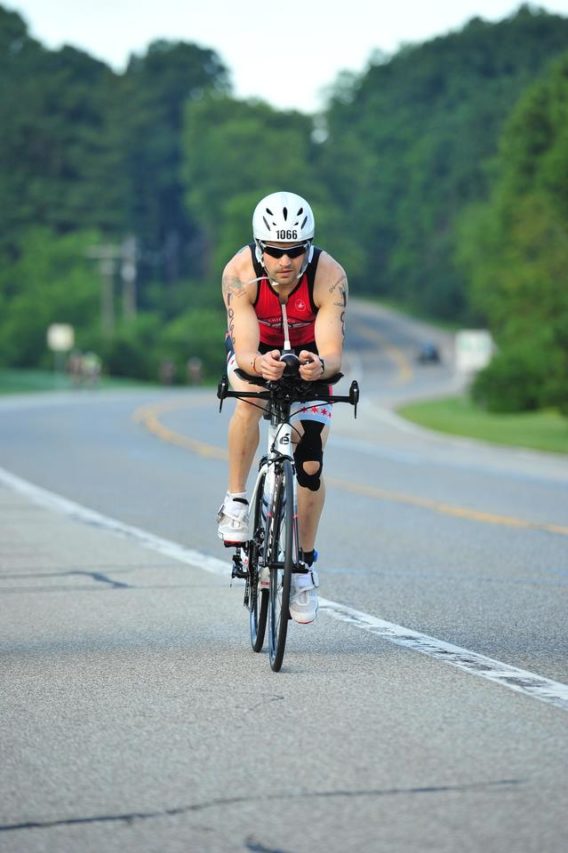
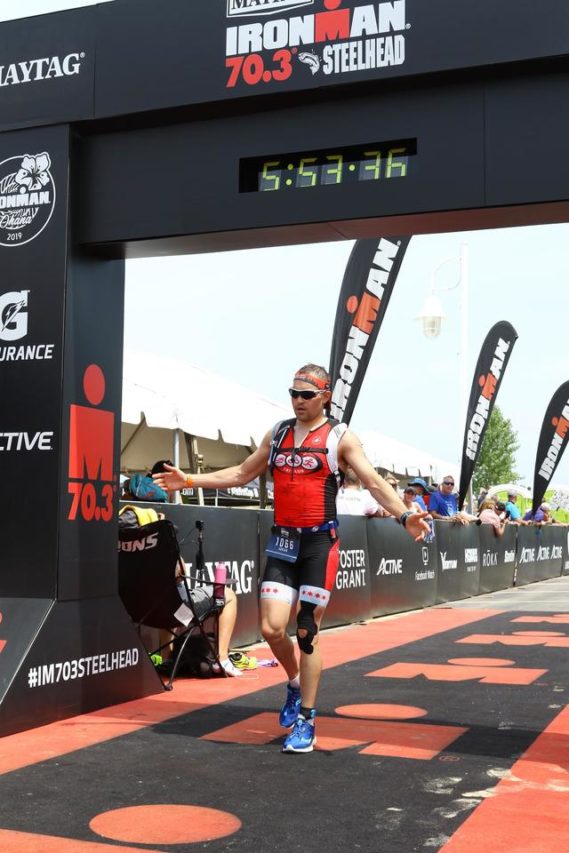
I took another week off from structured training, and despite my great bounce-back performance at Steelhead, I had to start thinking about how to train smartly and manage my knee issues over the next couple months leading up to the race in Madison.
The Big Day: hard work, persistence, and planning pay off
The next couple months of training were perhaps the most demanding part of the season. My training volume was slowly reaching its peak and I had to balance it carefully with proper recovery and physical therapy for my knee issues. Luckily, I had a very good physical therapist and movement expert available to me that I would see on occasion to keep me moving in the right direction.
I ended up traveling a couple times up to Madison to ride the bike course for some practice on the hills, and I’m really glad I did. I went into the race with much more confidence than I would have if I didn’t take the time to train on the course. My last couple open water swims in Lake Michigan were quite difficult, as the water always seemed to be choppy whenever I had a swim planned. Nevertheless, I sucked it up and swam through it, and once again I’m really glad I did. You just never know what the conditions will be like on race day. Fortunately, I was prepared for a choppy open water swim, and that’s exactly what Mother Nature gave me the day of the race.
Race day had finally arrived. It was time to access all the lessons I learned from my training and racing thus far and put them to use. The weather conditions that day were less than ideal for the swim and bike, however, they would prove to be ideal later for the run portion. The temperature would be in the 50s to start the day and end in the upper 60s, and rain showers were likely to develop later in the day.
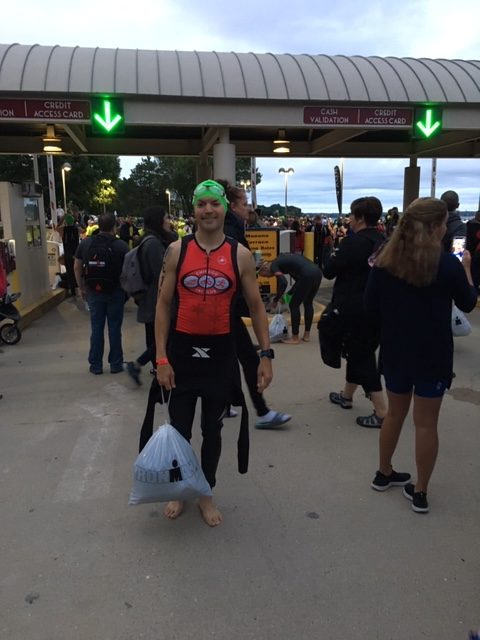
It was time to get into the water and begin the last long “training day”. As I stood in the starting corral next to 2,000 other athletes I took a glimpse at the water. Sure enough, it was a bit on the windier side and the waves were churning, but I didn’t quite realize how choppy it would be until I started swimming. The line inched forward as the athletes, five at a time, entered the water. It was my turn. As the race official yelled “ready, go!” I made my way into the water, walked a few steps until it was deep enough to swim, and I was on my way.
I settled into a comfortable pace. As I breathed to the right, I saw the mass of spectators lined along all four levels of the Monona Terrace Helix, a spiral parking structure which was the location of the race transition area. I had seen this view in pictures prior to the race, but there’s nothing quite like being in the water seeing all those awesome spectators cheering for you on that amazingly built architecture. It was quite a view and I gathered some extra motivation from it. As I continued further along the swim course, the waves got choppier and choppier. I kept my composure and went with them rather than fighting them. I exited the water 1 hour and 21 minutes later, slower than I had hoped for. I later learned that the swim portion had contributed to most of the DNFs (Did Not Finish) that day.
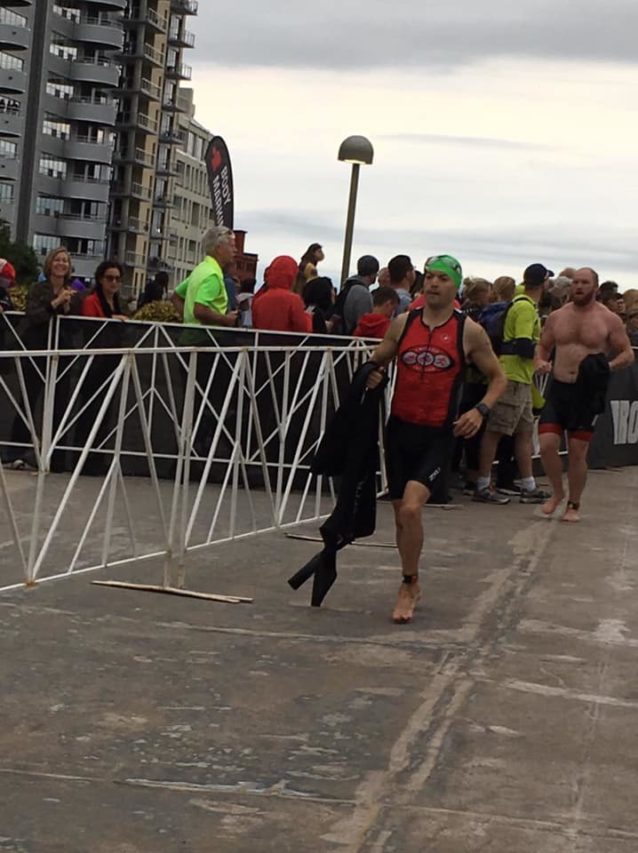
The crowd support running up the Helix was incredible. I saw my mom and sister at the top of the parking structure, just before entering the transition area. It was now time to start the longest and most notorious portion of the race; the bike. I ran out of the transition area and found my bike. I mounted it and carefully rode down the Helix, being careful not to go too fast. I settled into the bike course when I hit a bump which launched both of my rear nutrition bottles out of their cages. They came crashing down and exploded on the ground. Half my nutrition was gone before I even got 5 miles into the course. I had a specific carb drink I had been using all season with me and I did not want to mix any other carb drink from the aid stations, which would put me at risk for stomach issues on the run. I had to be very selective and conserve what nutrition I had left until mile 57 of the bike, where I could replenish my nutrition with extra bottles I had at the Special Needs Station.
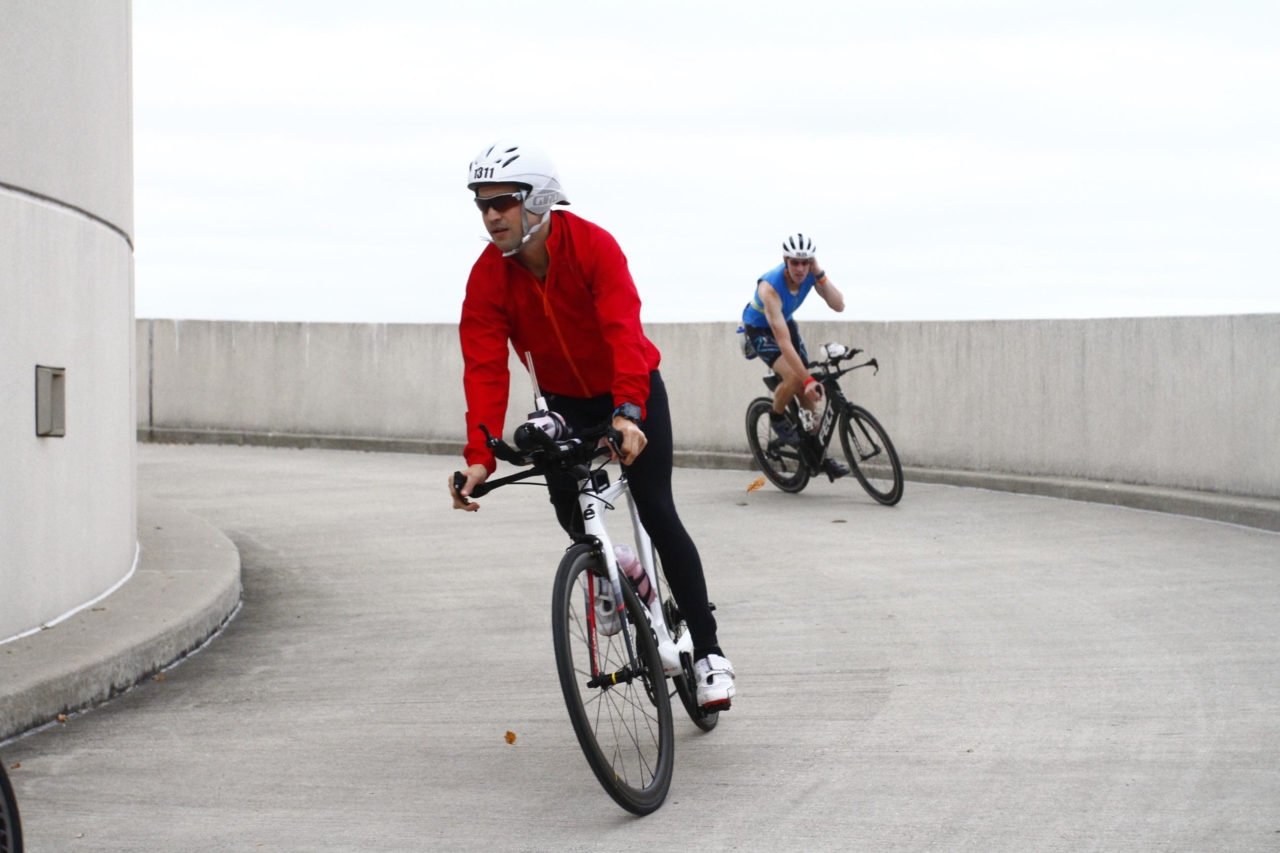
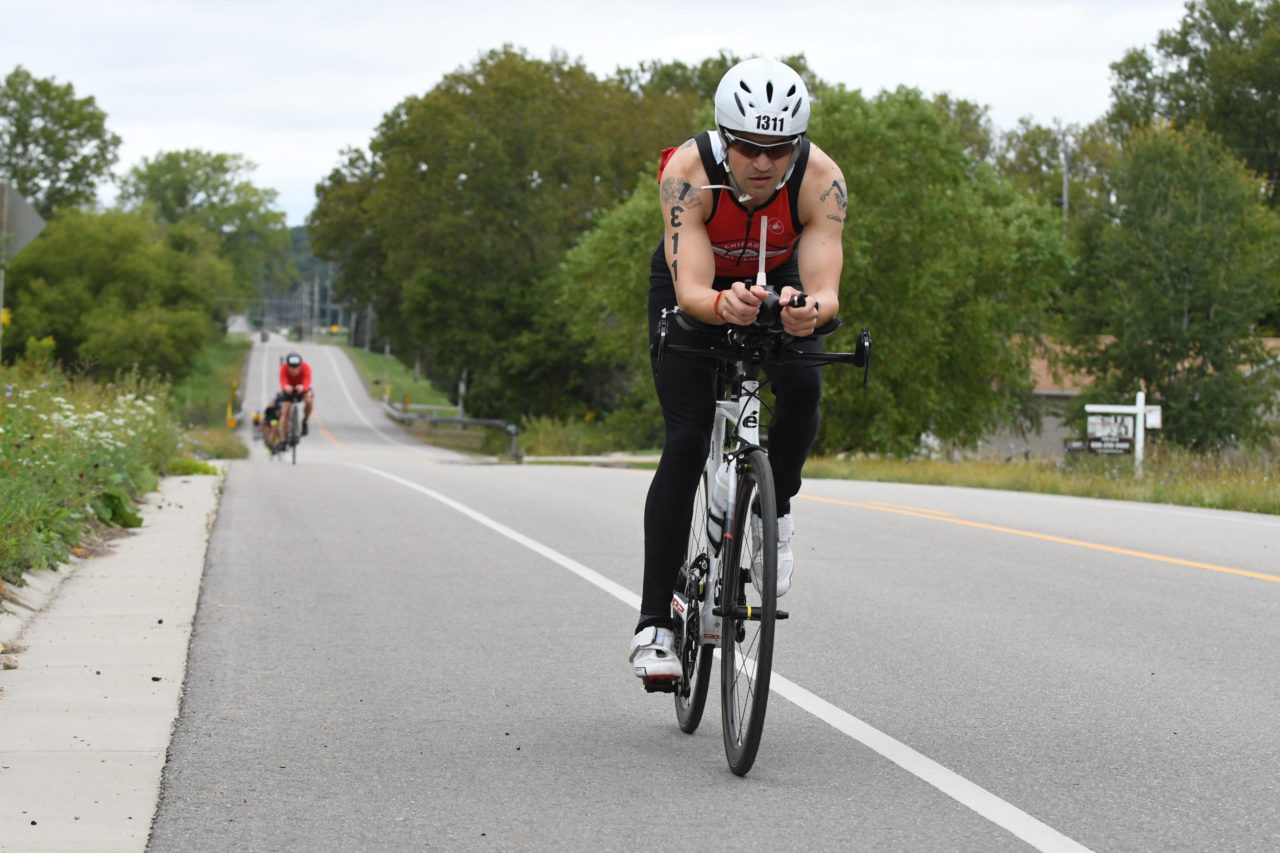
As I finally approached the Special Needs Station, my nutrition had just about run out. I was so glad I made it without having to drink the Gatorade provided on the course. I refilled and kept going. With about 15 miles to go, I was pleasantly surprised to see my mom and sister out in Verona (i.e. one of the towns the course went through) cheering me on as I passed them on my way to the transition area. It definitely gave me the spark I needed as rain showers slowly settled in. After 6 hours and 53 minutes, I made it back to the transition area and was pumped up to start the final stage of the race; the run.
As I grabbed my gear for the run and started to run out of the transition area I saw my family on the bridge above the parking garage continuing to cheer me on. This gave me a solid mental boost going into the tough 26.2 miles ahead. I was well on track to finish in my goal time of under 13 hours and as tired as I was, I found my running legs fairly quickly as I proceeded at a fairly brisk pace. A couple hours had passed and as always in an IRONMAN race, things started to get mentally and physically tough about halfway through the run. My legs and hips were screaming, I was hungry for something other than my UCAN nutrition drink, and I despised the race director for putting the u-turn for the 2nd loop so close to the finish line (just another mental barrier; I could see the finish line staring me in the face while I turned around to run 13 more miles). Despite the pain, I had to remind myself to take things one mile at a time and soon enough I would be at mile 20, with only a 10k left. Although my pace slowed, I continued, being sure to focus on my breathing and keep it relaxed. I eventually caught up to one of my buddies from the Chicago Tri Club and ran with him for a few miles (I was glad to hear from him the next day as he told me he had finished his first IRONMAN!).
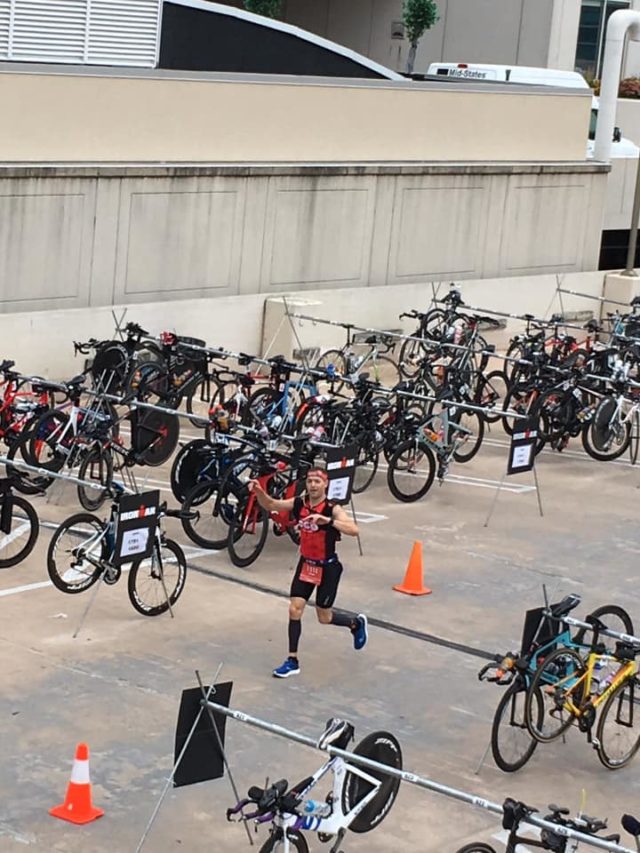
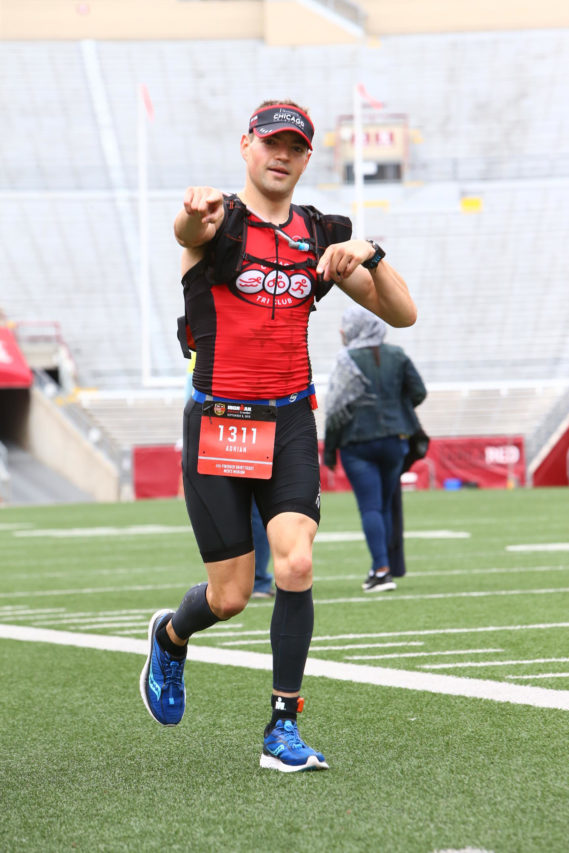
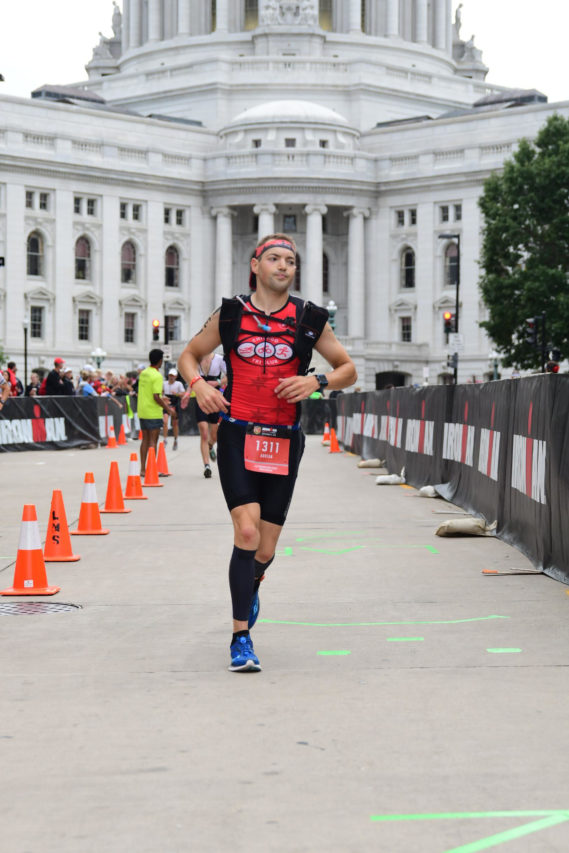
I eventually passed mile 20, then 21, 22, 23, 24, and finally 25. After I passed that mile 25 marker I knew I had made it. I could start to hear the noise of the cheering spectators of downtown Madison grow louder with every step. I didn’t care anymore about how bad things hurt. I was just a few minutes away from finishing my second IRONMAN in record time.
As I turned the corner past the Capitol building at mile 26 I began looking for my family. I spotted my mom just as I was making my left-hand turn to the finish line. A smile finally appeared on my face as she yelled out “you did it!”. I gave her a big hug then ran down the finishing chute to look for my sister. I couldn’t help but smile the whole time as I reached out to random spectators and give them high-fives for their support. As I reached the red carpet near the finish line, I finally spotted my sister. I ran over and gave her a hug before finishing up the race in a time of 12:48:55, a personal best and 11 minutes under my goal time for the race. It was an amazing experience, and one I’ll never forget. The many hours (~ 282) and months of hard, disciplined training had finally paid off.
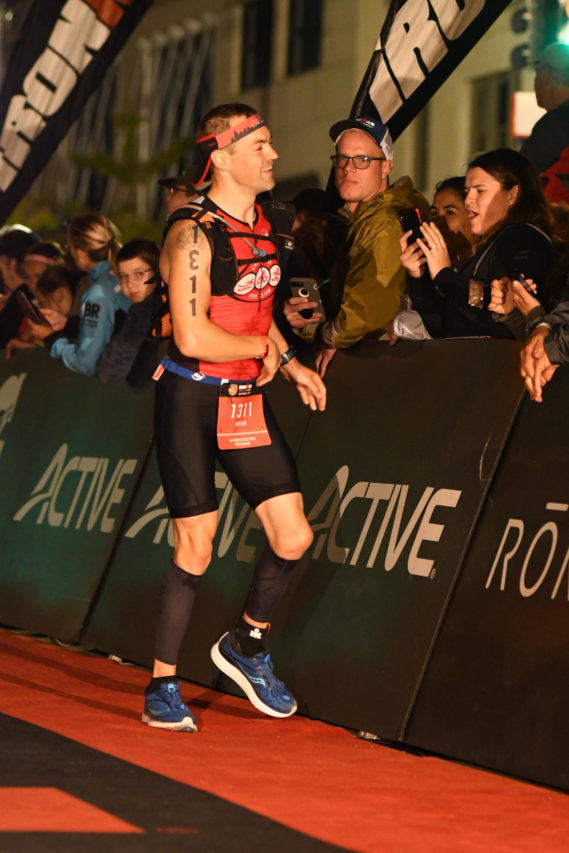
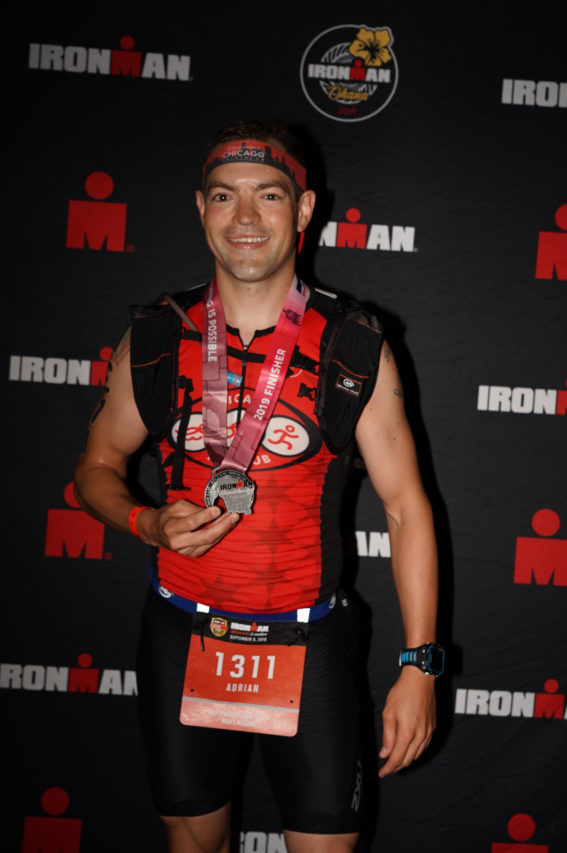
Key Takeaways
- Learn from your mistakes and failures. Being successful is great, but think about all the things you’ve learned from previous mistakes and failures that got you to where you are. Whether it’s your job, your family life, your health, or your fitness, noone is perfect. We all make mistakes. How do you respond to them? Do you use them to make yourself a better person in the future, or do you let them crush your dreams?
- Know yourself and what you’re capable of. Push your limits, but keep them realistic. Do you know what you’re truly capable of? Challenge yourself to do something you’re slightly scared of and think you’re not capable of. You’ll probably discover something about your character which has a great impact on your life and the lives of those around you. You don’t have to do an IRONMAN, a marathon, or a Spartan race, but find some obstacle that’s standing in your way, generate a plan, and go conquer it. You might find that your experience may change your life.
- Enjoy what you’re doing and know when to give yourself some time off. If it’s no longer fun, it’s time to back off. Every time I train for a race, I learn something new about myself. This time, I learned that I began training too early. I was very close to burnout and overtraining at several points throughout the season. I was mentally and physically exhausted in the last couple months before the race, and I found it difficult to find the motivation to train and have fun with it. I had trained for 8 solid months, with only a couple transition periods, which were probably not long enough. Next time I train for an IRONMAN, I’ll know 5-6 months will be plenty of time to prepare myself while still enjoying training and living a good life.
- Have a plan, and a backup plan. Have you considered what you might do if your number one plan doesn’t work out? This does not mean that you are expecting to fail. It means that you are hoping and planning for the best but preparing for the worst. You never know what cards life will deal to you. I was hoping not to lose any water bottles during the bike portion of my race, and even rubber-banding them to my water bottle cages didn’t do the trick, but it happened anyway after I hit a big bump. I thought about this before the race as a very real possibility, and I planned to be frugal with the nutrition I had left until I could refill at the halfway point. I would even settle with Gatorade if I needed to. Luckily, it wasn’t necessary. What plans and backup plans have you established for yourself? If you’re traveling and want to eat well, have you done a quick Google search on what grocery stores are near your destination? What if they’re closed or what if they don’t have the food you’re looking for? What are you comfortable settling with?
- Humility: never ever forget the people that support you. I could not have completed my first IRONMAN in 2016 or my second IRONMAN a couple weeks ago without the support of my family, period. My fiance, mom and sis, and my dad (when he was still with us a few years ago) supported me every step of the way; through all the emotional ups and downs of training, and helping with logistics on race day and taking awesome pictures and videos for memories. I can’t thank them enough. Spectating and supporting an athlete through an all-day endurance race is no easy task and they handled it like true badasses. They’re my IRONMAN Support Crew for life and I know I can count on them if I do another one of these crazy races in the future. Finally, as much as I love challenging myself and making myself a better athlete and person through these events, I hope you can see my success and use it to inspire yourself and others to do amazing things in your own lives. Get out there and do great things!


Adrian,
I’m incredibly proud of your accomplishment and have a lot of respect for your discipline and time management. You managed your studies and training while still being a big contributor to The Foundry. Thanks for being an inspiration to me and the rest of our community
-JQ
Great one sweetie! Happy your shared how you overcame a bad race outcome and turned it into a learning experience for the race that was the capstone of your season. <3
Thanks for posting this account of your training and race experiences, Adrian.
It is valuable for me to hear about the problems you had along the way, with your feet at Thunder, and your knee at Steelhead, and how learned from and worked through adversity. And to hear about the support from your family.
Thanks again, and see you later this week.